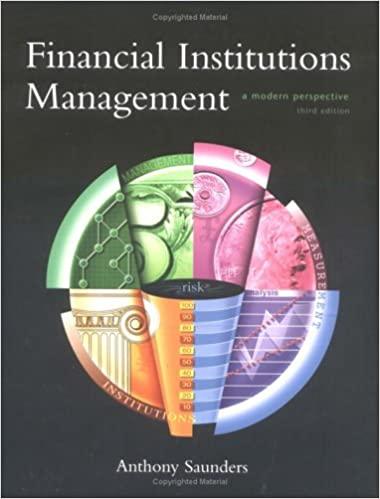Question
A. what effect would each of the following events likely have on the level of nominal interest rates? 1. Households dramatically increase there savings rate.
A. what effect would each of the following events likely have on the level of nominal interest rates? 1. Households dramatically increase there savings rate. 2. corporations increase their demand for funds following an increase in investment opportunities. 3. the government runs a larger-than-expected budget deficit. 4. There is an increase in expected inflation.
B. Suppose you are considering two possible investment opportunities: a 12 year Treasury bond and a 7-year, A-rated corporate bond. The current real risk -free rate is 4%; and inflation is expected to be 2% for the next 2 years, 3% for the following 4 years, and 4% thereafter. The maturity risk premium is estimated by this formula: MRP=0.02(t-1)%. The liquidity premium (LP) for the corporate bond is estimated to be 0.3%. You may determine the default risk premium (DRP), given the company's bond rating, from the table below. Remember to subtract the bond's LP from the corporate spread given in the table to arrive at the bond's DRP. What yield would you predict for each of these two investments?
| Rate | Corporate Bond Yield Spread= DRP+LP | |
| U.S Treasury | 0.83% | --- |
| AAA Corporate | 0.93 | 0.10% |
| AA Corporate | 1.29 | 0.46 |
| A Corporate | 1.67 | 0.84 |
C. Given the following Treasury bond yeild information, construct a graph of the yeild curve.
| Maturity | Yield |
| 1 year | 5.37% |
| 2 years | 5.47 |
| 3 years | 5.67 |
| 4 years | 5.71 |
| 5 years | 5.64 |
| 10 years | 5.75 |
| 20 years | 6.33 |
| 30 years | 5.94 |
D. Based on the information about the corporate bonds in part b, calculte yields and then construct a new yield curve graph that shows both the treasury and the corporate bonds.
E. Which part of the yield curve (left or right side) is likely to be the most volatile over time?
F. Using the Treasury yield information in part c, calculate the following rates using geometric averages:
1. The 1-year rate 1 year from now
2. The 5-year rate 5 years from now
3. The 10-year rate 10 years from now
4. the 10-year rate 20 years from now
Step by Step Solution
There are 3 Steps involved in it
Step: 1

Get Instant Access to Expert-Tailored Solutions
See step-by-step solutions with expert insights and AI powered tools for academic success
Step: 2

Step: 3

Ace Your Homework with AI
Get the answers you need in no time with our AI-driven, step-by-step assistance
Get Started


